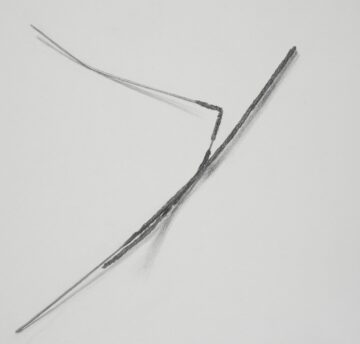Since 2010, Mariann Imre’s art project The Recording of Transience has gradually formed a cycle. This recurring title of her exhibitions does not denote a systematic exploration of a specific issue, but rather a series of stages that gradually expand in time and theme.
Her first work of this kind was a trail of a pram fixed in a pavement in Miskolc, which she recorded with red and blue threads in 2009. This was followed by the exhibition Curtain, then the Christmas tree project made of embroidered concrete in 2010; a year later, a more complex formulation: a bare Christmas tree floating above the floor with an embroidered “field” of fallen pine needles underneath.
From 2014 onwards, a succession of exhibitions with a more specific subtitle followed, such as the Linden Scent (2016), the Carpet and Crumbs (2017) and finally, in Szentendre, the Stripped Bare (2018).
Mariann Imre’s work does not deal with everyday themes. Rather, she uses the mysterious, symbolic materials of nature, or strange props bearing the marks of holidays and, more broadly, of sacredness, to express memory and passing metaphorically. Perhaps this is why the theme of Christmas recurs several times in his works.
For the present exhibition, this holiday also provides the broader plane of interpretation, which the artist evokes with its indispensable accessory, the sparklers. Imre has recorded his chosen motifs in sketchbooks, lighting them day after day, and arranging the sparkler stubs in random compositions. In a sense, the resulting pages are tiny “vanitas” images that fill the period between Christmas and Easter like a diary.
The artist strives to capture the elusive, the ‘non-ordinary’ fragments that emerge from the superimposed accumulation of minutes – the brief life, scent and smoke of the sparkler, the elevated atmosphere that surrounds family gatherings and the festive atmosphere. At the same time, her works can be characterized by pairs of opposites that exist in parallel, merging into one another: light and darkness, moment and continuity, time and timelessness, movement and impermanence, the profane and the spiritual, vulnerability and unbreakable solidity.
It is for this reason that his working method is characterized by a meditative, if you like, manic way of creating, based on repetition, on the almost notorious repetition of each movement, which allows these opposites to slide into each other. The artist’s works derive their strength from this intermediate existence between the external and the internal world, from which they derive their floating, weightless character, which gradually draws you into the abyss and leads you to introspection.
